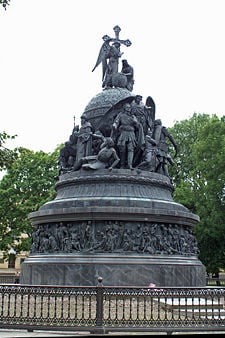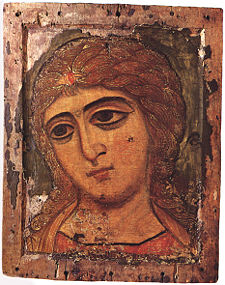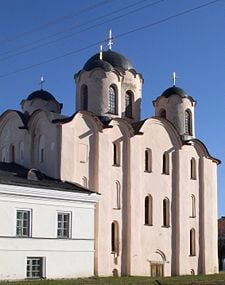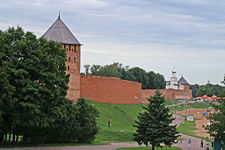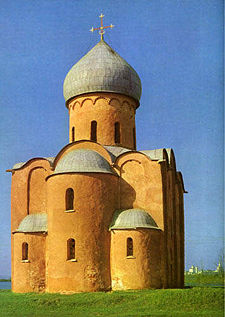Veliky Novgorod
| Historic Monuments of Novgorod and Surroundings* | |
|---|---|
| UNESCO World Heritage Site | |
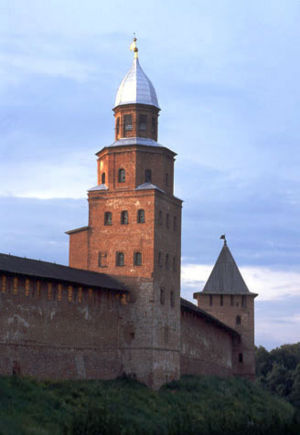
| |
| State Party | |
| Type | Cultural |
| Criteria | ii, iv, vi |
| Reference | 604 |
| Region** | European Russia |
| Inscription history | |
| Inscription | 1992 (16th Session) |
| * Name as inscribed on World Heritage List. ** Region as classified by UNESCO. | |
Novgorod, the third largest city in Russia, has deep historical roots to Russian culture as a whole.[1] Novgorod is famed as a center for Russian folk culture, because it does not experience the same influx of Western ideas and peoples found in Moscow or St. Petersburg. The preeminence of Veliky Novgorod in Russian culture is represented by the root of the name, where "Novgorod" is said to be the Russian word for "new city", and "Veliky" means "the Great".
Geography
Ancient Novgorod rose to a political force partially due to its ideal location with easy access to both the Oka and the Volga Rivers. It is located in the northwest region of Russia, an area commonly referred to as Russia's heartland. The title of the area reflects the high agricultural productivity of the region, as well as the overall economic importance of the area to Russia as a whole.
Novgorod is situated between the major metropolises Moscow and Saint Petersburg, and is rising to become a population center in its own right. Recent estimates put the population at 216,856, which while lower than the measurements in Soviet Times, still represents a large city by Russian standards.
Economy
Education is an incredibly important part of the Novgorod culture, as it was one of the first cities in Russian history to build a schoolhouse large enough to hold three hundred students at once. The high levels of education in Novgorod directly spawned many of the key industries for the city, particularly the book-making and printing industries. Novgorod also expressed its intellectual history through art, becoming a major center for icon painting and applied decorative arts.
Currently, much of the Novgorod economy is funded through foreign investment sources. Novgorod is widely considered to be one of the most economically open Russian cities, a fact corroborated by tax breaks offered to foreign investors by the local government. Foreign investors tend to focus on heavy industry, particularly the radio-electronic, furniture, chemical fields. The high levels of investment have had some effect on the local population, raising the living standard above many other urban centers in Russia. In particular, Novgorod has a smaller homeless population than Moscow or St. Petersburg.
History
Novgorod was among the first cities to be formed in ancient Russia. Due to its proximity to the rivers, a small civilization sprouted that connected the Greek markets to the Russian and Baltic markets. Archaeological evidence regarding the trade dates the city to the tenth century C.E., when Christianity first made its way into Russia. [2] Along with the ideas of Christianity, religious evangelists brought trade items to be traded in urban centers to fund their travels. While some records mention Novgorod as an urban center prior to the tenth century, it must be assumed that earlier accounts exaggerate the importance of the settlement, due to the lack of archaeological evidence to support a large city at an earlier time.
Princely state within Kievan Rus'
In 882, due to its growing economic and political authority, Oleg of Novgorod captured Kiev and founded the state of Kievan Rus. The city soon became the second most powerful city in Kievan Rus. It was ruled by a series of political organizations, called posadnicks, which governed when the ruler had no son to inherit the throne. When not being ruled by posadnicks, Novgorod had the good fortune to experience a series of benevolent rulers who governed with the best interest of the city's inhabitants in mind.
In Norse sagas the city is mentioned as the capital of Gardariki (i.e., the East Slavic lands). Four Viking kings — Olaf I of Norway, Olaf II of Norway, Magnus I of Norway, and Harald Haardraade — sought refuge in Novgorod from enemies at home. No more than a few decades after the death and subsequent canonization of Olaf II of Norway, in 1028, the city's community had erected a church in his memory, Saint Olaf's Church in Novgorod.
After the tenth century, Novgorod emerged as a strong political and religious center. Its secure position was primarily due to Novogorod's strong military onslaught against Constantinople. As a result of the military campaign, Novgorod maintained equal trading rights with Byzantine and began a cultural interchange. East Slavic tribes from Byzantine began pouring into the ancient Slavic state, influencing the art and culture of Novgorod.
The most notable among the benevolent leaders of Novgorod was Yaroslav I the Wise,who had sat as prince while his father, Vladimir the Great, was prince in Kiev. Yaroslav promulgated the first written code of laws (later incorporated into Russkaya Pravda) among the Eastern Slavs and is said to have granted the city a number of freedoms or privileges, which they often referred to in later centuries as precedents in their relations with other princes. His son, Vladimir, sponsored construction of the great St Sophia Cathedral, more accurately translated as The Cathedral of Holy Wisdom, which remains in modern times.
His Majesty Lord Novgorod the Great
In 1136, the Novgorodians dismissed their prince Vsevolod Mstislavich. This date is seen as the traditional beginning of the Novgorod Republic. The city was able to invite and dismiss a number of princes over the next two centuries, but the princely office was never abolished and powerful princes, such as Alexander Nevsky, could assert their will in the city irrespective of the Novgorodians' wishes.[3] The city state controlled most of Europe's North-East, from today's Estonia to the Ural Mountains, making it one of the largest states in medieval Europe, although much of the territory north and east of Lakes Lagoda and Onega were sparsely populated and never organized politically.
One of the most important local figures in Novgorod was the Posadnik or mayor, an official elected by the public assembly (called the Veche) from among the city's boyarstvo or aristocracy. The tysyatsky, or "thousandman," originally the head of the town militia but later a commercial and judicial official, was also elected by the veche. The Archbishop of Novgorod were also important local officials and shared power with the boyars.[4] They were elected by the veche or by the drawing of lots; after their election, they were sent to the metropolitan for consecration.[5]
While a basic outline of the various officials and the veche can be drawn up, the city-state's exact political constitution remains uncertain. The boyars and the archbishop ruled the city collectively, although where one officials power ended and another's began is uncertain. The prince, although reduced in power beginning in about the mid-twelfth century, was represented by his namestnik or lieutenant, and still played important roles as a military commander, legislator, and jurist. The exact composition of the veche, too, is uncertain, with some scholars such as Vasily Kliuchevksii claiming it was democratic in nature, while later scholars, such as Valentin Ianin and Alesandr Khoroshev, see it as a "sham democracy" controlled by the ruling elite.
In the 13th century, Novgorod, while not a member of the Hanseatic League, was the easternmost kontor, or entrepot, of the league, being the source of enormous quanties of luxury (sable, ermine, fox, marmot) and non-luxury furs (squirrel-pelts).[6]
Throughout the Middle Ages, the city thrived culturally. A large number of birch bark letters have been unearthed in excavations, perhaps suggesting wide-spread literacy, although this is uncertain (some scholars suggest that a clerical or scribal elite wrote them on behalf of a largely illiterate populace). It was in Novgorod that the oldest Slavic book written north of Macedonia and the oldest inscription in a Finnic language were unearthed. Some of the most ancient Russian chronicles were written in the archbishops' scriptorium and the archbishops also promoted iconography and patronized church construction. The Novgorod merchant Sadko became a popular hero of Russian folklore.
Novgorod was never conquered by the Mongols during the Mongol invasion of Rus. The Mongol army turned back about 100 km from the city, not due to the city's strength, but probably because the Mongol commanders did not want to get bogged down in the marshlands surrouding the city. That being said, the grand princes of Moscow, who acted as the tax-collectors for the khans of the Golden Horde, did collect tribute (dan) in Novgorod, most notably Yury Danillovich and his brother, Ivan Kalita.
Under a series of benevolent rulers, the inhabitants of Novgorod were steadily granted increased independence and political autonomy. As a result of their increased role in the political process, it soon became apparent to the inhabitants of Novgorod that a singular ruling authority was not necessary for Novgorod to function. As a result of this revelation, the Novgorodians dismissed their prince in 1136. In order to fill the political void, Novgorod established the Novgorod Republic, which invited and dismissed a series of princes in order to rule Novgorod. While the veche, or electing authority, maintained supreme nominal power, some powerful leaders were able to assert a strong agenda over the objections of the people.[7]
Novgorod, with its unique political structure,soon became a thriving center for arts and culture. During the Medieval Ages Novgorod gained its reputation for literacy and education, a reputation that stayed with the city for most of its legacy. Written records at this time are in the form of birch bark documents, many of which were written in the archbishop's scriptorium. Possibly due to the intellectual and cultural strength of Novgorod, Novgorod did not fall during the Mongol invasion of ancient Russia. During this invasion, many surrounding cities fell to the Mongol invaders, but the cultural beacon of Novgorod resisted the invasion.
Despite being able to resist the Mongol invaders, Novgorod began to falter politically in the early 15th century C.E. Many scholars trace Novgorod's crumbling political power to an inability to provide the basic needs for its inhabitants. The citizens of Novgorod were particularly threatened by a lack of grain, which drove many citizens close to starvation. In order to rectify the lack of bread Novgorod made a political agreement with Moscow and Tver to provide much needed grain. These cities used the agreement to exercise political control over Novgorod, and the city's independence began to weaken in proportionate to its dependence on Moscow and Tver for grain. Novgorod was eventually annexed by Moscow in 1478.
The difficulties for Novgorod continued in the Time of Trouble, when the city fell to Swedish troops. According to some accounts, the city voluntarily submitted to Swedish rule. Novgorod continued under Swedish authority for six years, after which time it was returned to Russia and allowed to rebuilt a level of political authority. After the transfer of Novgorod to Russia, Novgorod began an ambitious program of building and many of its most famous structures were constructed during this time period. Notable examples of this period of architecture include the Cathedral of the Sign and Vyazhischi Monastery. Novgorod became the administrative center of the Novgorod Governorate in 1727, demonstrating its reclaimed importance to Russia. Novgorod continued to be important to Russia until World War II, when German troops occupied the city and destroyed many of the historical and cultural landmarks.
Sights and Landmarks
The cultural and religious legacy of Novgorod is most apparent in the many churches that dot the countryside. The most apparent religious structure in the city is the Saint Sophia Cathedral in Novgorod, which was built between 1045 and 1050. [8] The Cathedral is one of the most finely preserved examples of 11th century Russian architecture. It is particularly noted for its Russian style architecture, sharply different from the French inspired architecture favored by previous Russian royal families. One of the most prominent features of the cathedral is its distinctive bronze gates, which were originally thought to have been made in Magdeburg during the 12th century C.E., but have now found to been purchased late into the 15th century. [9]
A distinctively different architectural style is apparent in the Saviour Cathedral of Kutyn Monastery, which is patterned after the cathedrals in Moscow. This church, along with other churches built during the fifteenth century, is patterned after Muscovite architectural trends.
Notes
- ↑ The Archaeology of Novgorod, by Valentin L. Yanin, in Ancient Cities, Special Issue, (Scientific American), pp 120–127, c 1994. Covers, History, Kremlin of Novgorod, Novgorod Museum of History, preservation dynamics of the soils, and the production of Birch bark documents.
- ↑ V. L. (Valentin Lavrent’evich) Ianin and M. Kh. (Mark Khaimovich) Aleshkovskii, “Proskhozhdenie Novgoroda: (k postanovke problemy),” Istoriia SSSR 2 (1971): 32-61.
- ↑ Michael C. Paul, “The Iaroslavichi and the Novgorodian Veche 1230-1270: A Case Study on Princely Relations with the Veche,” Russian History/ Histoire Russe 31, No. 1-2 (Spring-Summer 2004): 39-59.
- ↑ Michael C. Paul, “Secular Power and the Archbishops of Novgorod Before the Muscovite Conquest.” Kritika: Explorations in Russian and Eurasian History 8, no. 2 (Spring 2007): 231-270.
- ↑ Michael C. Paul, “Episcopal Election in Novgorod, Russia 1156-1478.” Church History: Studies in Christianity and Culture 72, No. 2 (June 2003): 251-275.
- ↑ Janet Martin, Treasure of the Land of Darkness: the Fur Trade and its Significance for Medieval Russia. (Cambridge: Cambridge University Press, 1985).
- ↑ Michael C. Paul, “The Iaroslavichi and the Novgorodian Veche 1230-1270: A Case Study on Princely Relations with the Veche,” Russian History/ Histoire Russe 31, No. 1-2 (Spring-Summer 2004): 39-59.
- ↑ Tatiana Tsarevskaia, St. Sophia's Cathedral in Novgorod (Moscow: Severnyi Palomnik, 2005), 3.
- ↑ Irena Daniec Jadwiga, The Message of Faith and Symbol in European Medieval Bronze Church Doors (Danbury, CT: Rutledge Books, 1999), Chapter III "An Enigma: The Medieval Bronze Church Door of Płock in the Cathedral of Novgorod," 67-97; Mikhail Tsapenko, ed., Early Russian Architecture (Moscow: Progress Publisher, 1969), 34-38
ReferencesISBN links support NWE through referral fees
- Costantino, Maria. 2001. The Illustrated Flag Handbook. New York: Gramercy Books. ISBN 0-517-21810-0
- Lewis, Brenda Ralph. 2002. Great Civilizations. Bath: Paragon Publishing. ISBN 0-75256-141-3
- DK Publishing, Great Britain (Eyewitness Guide). New York: DK Publishing. ISBN 0756615429
External links
- Novgorod the Great site Retrieved December 17, 2007.
- Veliky Novgorod for tourists Retrieved December 17, 2007.
- The Faceted Palace of the Kremlin in Novgorod the Great site Retrieved December 17, 2007.
- Novgorod - monuments of ancient architectureRetrieved December 17, 2007.
- Guide to Novgorod Retrieved December 17, 2007.
- Introduction to Novgorod Retrieved December 17, 2007.
- What is Novgorod? Retrieved December 17, 2007.
Credits
New World Encyclopedia writers and editors rewrote and completed the Wikipedia article in accordance with New World Encyclopedia standards. This article abides by terms of the Creative Commons CC-by-sa 3.0 License (CC-by-sa), which may be used and disseminated with proper attribution. Credit is due under the terms of this license that can reference both the New World Encyclopedia contributors and the selfless volunteer contributors of the Wikimedia Foundation. To cite this article click here for a list of acceptable citing formats.The history of earlier contributions by wikipedians is accessible to researchers here:
The history of this article since it was imported to New World Encyclopedia:
Note: Some restrictions may apply to use of individual images which are separately licensed.
